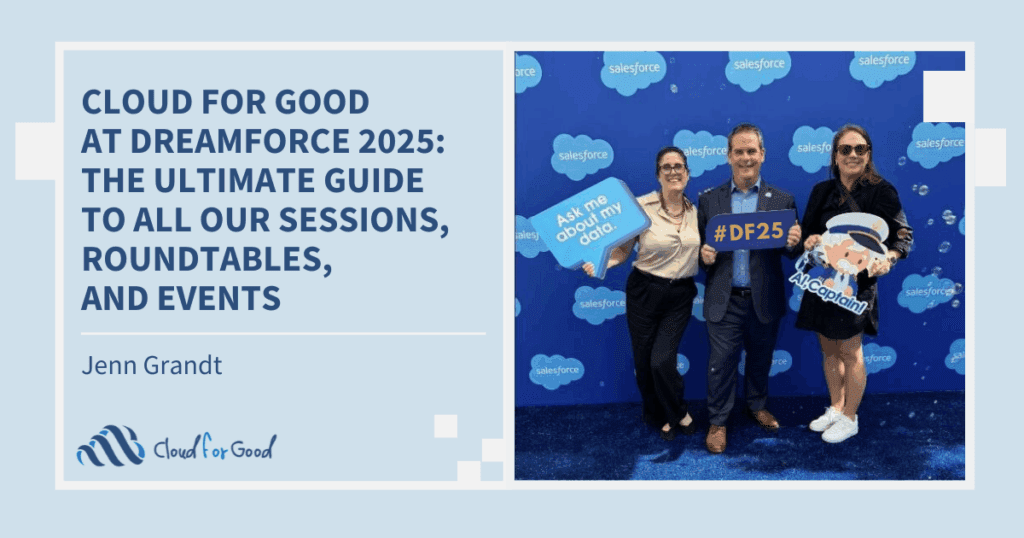If you’ve been using Sales Cloud and are considering Marketing Cloud, then you most certainly will want to consider integrating these two powerful products using Marketing Cloud Connect. This tool is the latest name of the integration between Sales and Marketing Cloud (I say ‘latest’ because it has seen its share of name changes over the years).
Perhaps you have already integrated and are not taking full advantage of the integration capabilities. Either way, I’ve outlined a few of the powerful benefits of the tool and also point out a few drawbacks below.
Sync any object’s Sales Cloud data to the Marketing Cloud.
You heard me right. It’s true. You can sync any object’s data from Sales + Service Cloud and pull that data into Marketing Cloud. Why would you want to do this? There are plenty of reasons why. The most common reason is to create a master segment of your Contacts or Leads from Sales Cloud within Marketing Cloud. Then once you have this master segment, you can set up automations for further segmentation and email sends and also push these Contacts into specific Journeys for 1:1 marketing. Pulling this off is very possible and can really streamline your marketing efforts.
Your synced object data can be pulled in at 15 minute intervals, so the delay from a modified record in Sales Cloud being pushed to Marketing Cloud is pretty minimal.
Trigger Journeys without syncing data
Remember when I said you could sync any object? Well, it’s still true. But you don’t necessarily have to do this because you can actually trigger journeys in Journey Builder based on your Sales Cloud data. This simplifies the process of utilizing Sales and Service Cloud data for marketing automation. Perhaps you want to automatically send out a Welcome email after
Or maybe a survey invite after a Case is closed? You can do both relatively easily. One thing to note, however, is that your journey may still need to utilize Synced data, in particular if you need to have decision splits in your journey based on data that will be updating in Sales Cloud.
You can update Sales & Service Cloud data from within a journey
The ability to create and update object data in Sales Cloud + Service from journey builder should fulfill your wildest 1:1 marketing dreams! You can base an update on whether a user opened a specific email or clicked a specific link (perhaps you want to automatically create aCase after a Contact takes a specific path in your journey). You can also update custom objects. There are a few scenarios that I’ve encountered that don’t work perfectly (i.e. working withPersonAccounts and CampaignMember objects did not go swimmingly), but for the most part, triggering a journey entry event plus updating Sales Cloud data from Journey Builder are the true stars of Marketing Cloud Connect.
Marketing Cloud Connect : Setting Expectations
Although Marketing Cloud Connect is very powerful and can solve a large number of your business problems, there are also some elements that require expertise to ensure success. Here are some expectation setting suggestions for utilizing Marketing Cloud Connect to its fullest.
Salesforce Reports
You may have created lots of really great Reports in Sales Cloud for segmentation purposes. Marketing Cloud can in fact utilize these as your sendable audience when using a Send Definition or Guided Send. However, that is essentially the primary use of Sales Cloud Reports in Marketing Cloud. You cannot sync the data from a Salesforce Report like you can with a Salesforce object. Previously, you could pull in data from a Sales Cloud report utilizing the Marketing Cloud Import Activity, but that feature has essentially been deprecated (and for good reason, it was buggy, could not handle large number of records, and generally was not a good user experience). Synchronized Data Extensions replaced this Report import option, but Synchronized Reports is not yet a feature of Marketing Cloud Connect (and it really needs to be a feature, and soon).
Your Process Workflow likely needs some architecting
Some Salesforce users want to run their business from Sales Cloud. Others have a marketing team that work primarily in Marketing Cloud. Some want to be sending emails in both Marketing Cloud and Sales Cloud. All options are possible. However, you need to carefully consider the flow of your data and emails to ensure your solution can properly scale across all of your scenarios. Which leads me into the Mobile Connect integration…
MobileConnect integration
MobileConnect is Marketing Cloud’s MMS/SMS tool. It’s fun to play with and works really well to market to your customers via SMS (better known as a text message). This component of Marketing Cloud is not well integrated with Sales Cloud. If you want to send an SMS directly from Sales Cloud via MobileConnect, you’ll need a journey or automation to handle this. And if you have expectations that the SMS sent to a particular Contact will then show up in Sales Cloud on that Contact record (similarly to Email tracking data), then you will be disappointed, as this is not currently data that is passed back into Sales Cloud on the Contact record. If you are using MobileConnect and would like to send SMS with your Sales Cloud data, you are more than likely going to need to solution this on the Marketing Cloud side of the house.
Your best bet is to use Sales Cloud as your database of record
Let’s say you have a list of 500 records that you do not want to load into Sales Cloud (I’m not sure your reasoning for this, but for some reason, it comes up pretty regularly). You do still want to send out an email via Marketing Cloud to these subscribers. Your synced subscribers from Sales Cloud will utilize Contact ID or Lead ID as a subscriber key (the unique identifier within Marketing Cloud). So, if you load these records directly into Marketing Cloud (without loading into Sales Cloud first), you’ll need to use some other identifier – typically email address. This is not a terrible thing to do, however, it creates duplication risks.
Marketing Cloud does not provide deduplication features
Should any of your 500 records in the example above some day make their way into Sales Cloud, you now have duplicates in Marketing Cloud. This is not good from a user experience (i.e. the Contact now has two profiles / subscriptions to manage). Marketing Cloud has built in ways to limit the same subscriber receiving the same email per send, however, there are not built-in duplication features that allow you to identify and merge your subscribers. So should you encounter duplicates, getting rid of these duplicates is a manual process. And eliminating one of the duplicates also can mean losing the corresponding historical data for this subscriber.The same goes for if you delete or deduplicate a Contact from Sales Cloud – the duplicate record in Marketing Cloud may still exist in All Subscribers / All Contacts.
Marketing Cloud does not have Sandboxes that rival Sales Cloud sandboxes
Technically, Marketing Cloud has sandbox accounts. However, you must purchase these, and most clients do not. The Marketing Cloud sandbox has no relationship / knowledge of a corresponding production account, so it’s utility is limited to just being a separate area to build out your solution (i.e. there is no “push to production” change set feature in the Marketing Cloud). If you were expecting to have a Marketing Cloud sandbox connected to your Sales Cloud sandbox, and a Marketing Cloud production account connected to your Sales Cloud production…you will be somewhat disappointed as this is a very uncommon scenario. If this is a must, it is possible, but be prepared to pay more for both the product costs (multiple Marketing Cloud accounts) and additional cost for implementation.
Tracking Data pushed from Marketing Cloud to Sales Cloud can utilize a ton of Sales Cloud data.
This is something you likely should have expected to hear. If you want to see all of your Marketing Cloud email tracking data within Sales Cloud, you need to be prepared to pay for it.You presumably have 10gb of Sales Cloud storage now – if you are sending out lots of emails toa large Contact list, and you want all/most of this email tracking data stored in Sales Cloud, then prepare for your Sales Cloud storage to be gobbled up.
The Marketing Cloud Connect integration does allow you to opt for less of this data to be stored in Sales Cloud (i.e. only the last 30 days and do not push individual links clicked), and that will help with any data storage limits. Also, know that the same data will continue to live in Marketing Cloud, so it’s most likely not an absolute must for you to have all of this tracking data in Sales Cloud.
Testing Journeys with Sales Cloud data requires live testing
The Journey testing feature continues to evolve and become more useful. The April ‘19 Marketing Cloud release gave us more advanced testing features that allow us to simulate the paths of our journey entrants based on a data extension. However, this feature does not yetwork using Sales Cloud entry audiences, and it also does not provide any method of showing us what a Sales Cloud activity will do in testing mode (i.e., will a new Lead record be created by thejourney; will the Case be created)? This seems like it will be a complex feature to be developed, but in order for the journey testing feature to cover all scenarios, it will need to be considered by the Salesforce product team. This is not a big issue, as live testing a journey is still the best practice before launching the journey.
All Contacts and Contacts integration are primarily a one-way sync
For the most part, I describe the Marketing Cloud Connect sync as a one-way sync from Sales Cloud to Marketing Cloud. There are exceptions as they related to Email Send Tracking data, unsubscribe data, and Journey Builder’s integration (we covered the journey builder two waysync earlier). But for the most part, the Marketing Cloud Connect is not a true bi-directional sync. Any updates to Marketing Cloud do not necessarily reflect in Sales Cloud. If you make a change to a Contact’s first name in Marketing Cloud’s All Contacts, this will not be reflectedback on the Contact record in Sales Cloud. This to me, is a big area for opportunity for the Salesforce team (hint, hint Product folks – please move bi-directional syncing to the very top of the list). In general, Subscriber & Contact management in Marketing Cloud is still a spot that needs improvements – creating a single view of a Contact is what we’re after, but the integration is not quite there yet.
Just syncing Contacts, Users, Leads or Person Accounts into Marketing Cloud count towards your total Contact purchase
Continuing our discussion on Contact management…your mistakes in architecting your solution can cost you. Like, actual money. The reason for this…Salesforce charges per Contact. This seems like it would not cause problems, but it occasionally does.
Essentially, when you choose to sync the Contact object from Sales Cloud into Marketing Cloud,the moment those Contacts are synced, however many Contacts you pull in now count towards the total Contacts purchased with your Marketing Cloud contract. My recommendation here is to ensure you’re only pulling in Contacts you plan on being part of your marketing efforts. Marketing Cloud Connect does allow you to add a filter based on a Boolean field in your Sales Cloud object, so this can help you minimize the number of Contacts or Leads you pull in. However, this filter currently only allows you to utilize a Boolean field, and not any other type of field.
Additionally, the rules for how a Contact is counted are not at all simple to comprehend (see this Salesforce documentation for validation of my statement).
Finding success with Marketing Cloud Connect is very possible. However, you will benefit from utilizing a trusted advisor like Cloud for Good to help you navigate the potential pitfalls that exist. We’d be happy to help!





